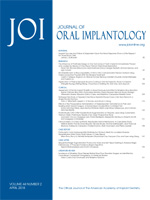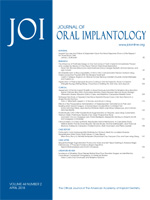
Journal of Oral Implantology Volume 47 Issue 2
Some data suggest that these drugs in combination with dental implants can increase a patient’s risk for Medication-Related Osteonecrosis of the Jaw (MRONJ), a disease that interferes with the normal turnover of the jawbone and impedes a patient’s quality of life.
LAWRENCE, Kan. (PRWEB)
June 22, 2021
Journal of Oral Implantology – Healthy bones undergo a process in which old bone is broken down and replaced with new bone. Conditions, such as osteoporosis, can cause an imbalance in this process and result in weak bones. Systemic medications can mitigate this imbalance; antiresorptive drugs increase bone strength by slowing bone turnover. Some data suggest that these drugs in combination with dental implants can increase a patient’s risk for Medication-Related Osteonecrosis of the Jaw (MRONJ), a disease that interferes with the normal turnover of the jawbone and impedes a patient’s quality of life. However, there is little understanding regarding MRONJ risk factors in these patients and whether they contribute to dental implant loss. A recent study in the current issue of the Journal of Oral Implantology examined publications to determine the risk of MRONJ and dental implant failure in patients on antiresorptive drugs.
Researchers from the National and Kapodistrian University of Athens in Greece conducted a systematic review of scientific articles in PubMed/Medline by using set search terms. Their inclusion and exclusion criteria are detailed in the review, which resulted in 32 articles, and contained 5,221 patients, 12,751 implants, 618 cases of implant loss, and 136 cases of MRONJ.
The 32 articles were split into 2 groups. Group 1 included studies on dental implant success rates in patients with a history of taking antiresorptive drugs and did not present with MRONJ. Most studies reported (18/22) that resorptive therapy use is safe in patients undergoing dental implant surgery because dental implant failure was low and MRONJ cases were absent. However, the authors detail limitations of these studies that make their conclusion problematic, including missing control groups, limited patient samples, short follow-up periods, and the lack of clinical and radiographic follow-up, which is the only way to diagnose MRONJ. In addition, some studies presented evidence that oral bisphosphonates, the most common antiresorptive drugs, may increase bone loss and, thus, increase the risk of implant failure.
Group 2 included studies of patients with dental implants, a history of taking antiresorptive drugs and presented with MRONJ. Some studies did not provide a conclusion, whereas others concluded that MRONJ is a complication of dental implants. Furthermore, several studies suggested that MRONJ can develop many months or years after dental surgery, even when antiresorptive treatment begins after implant placement. However, group 2 had limitations similar to those of group 1 that prevented the authors from stating that MRONJ is a late complication in these cases.
The authors provide suggestions as to how clinicians can conduct successful dental implant surgery in patients taking antiresorptive therapies. Some suggestions include informing the patient about the importance of oral hygiene (to prevent MRONJ), use of antibiotics, drug holidays, and frequent follow-up exams. Additionally, because MRONJ in group 2 occurred mostly in the posterior locations of the jaw, clinicians should be careful when planning implants in this area.
Overall, given the few studies on this topic and the low quality of the available studies, the authors could not state whether antiresorptive drug use is a risk factor for increased dental implant failure and/or if MRONJ is a late complication. Resorptive medication use is widespread and dental implant procedures are increasing; therefore, in the future, researchers and clinicians need to gain a better understanding regarding the intricacies involving dental implant success rates, antiresorptive therapy, and MRONJ.
Full text of the article, “Success Rate and Safety of Dental Implantology in Patients Treated With Antiresorptive Medication: A Systematic Review,” Journal of Oral Implantology, is available at https://doi.org/10.1563/aaid-joi-D-19-00088.
About the Journal of Oral Implantology
The Journal of Oral Implantology is the official publication of the American Academy of Implant Dentistry and of the American Academy of Implant Prosthodontics. It is dedicated to providing valuable information to general dentists, oral surgeons, prosthodontists, periodontists, scientists, clinicians, laboratory owners and technicians, manufacturers, and educators. The JOI distinguishes itself as the first and oldest journal in the world devoted exclusively to implant dentistry. For more information about the journal or the society, see http://www.joionline.org
Share article on social media or email:

